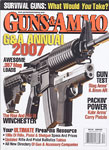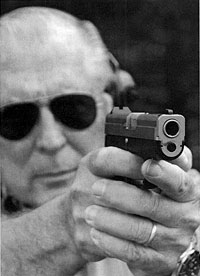
Upping the Ante
At long last, Kahr bumps up the bore size on its handy semiauto to .45 ACP.
Guns & Ammo Annual 2007, p. 70 - 71 By Stan Trzoneic

It doesn't take a rocket scientist to figure out that when anyone decides to market a new handgun or make an addition to the line, the .45 ACP cartridge should be at the top of the list. But in the case of Kahr, the 9mm K9 was followed by the .40 S&W K40, and nothing was ever mentioned about a .45-caliber, compact semiautomatic pistol. Now the time has come; the brand-new P45 has joined the ranks within the company.
Available in all black or two-tone (light slide contrasted against a black frame), the gun is a natural in the hand. Fed by a single-stacked, six-round magazine, the P45’s grip-frame girth is perfect for a carry gun, and there's a small polymer extension on the magazine base to accommodate three fingers of the average hand.
The rear of the grip frame, which houses the mainspring, is arched with just enough of a curve to fit within your palm, and both the front and back of the frame are heavily serrated for additional purchase of the gun during firing.
The entire frame is polymer, and the grip sides are molded with a slight tooth to look like grip panels, complete with the Kahr logo. The rest of the frame is mottles for anti-reflection. The trigger guard is large enough to accommodate cold-weather gloves and in design lacks any sort of hook, forward-slanting appendage or stippling.
Around the trigger guard are the usual operator controls. Directly above the trigger is the slide release or latch. With a snick downward, it releases the slide without any hesitation. While the release may appear small in photographs, in real life it is positioned so that the thumb of the shooting hand can reach it without any sort of contortion—such as turning the gun side—ways to use it. It's finished to match the slide and is serrated and angled for ease of use.
To the rear of the trigger is the magazine release. When pressed inward it allows the magazine to drop out of the magazine well with much enthusiasm. However, installing the magazine requires you to push hard to seat it.
The Kahr P45 is double-action only, with the trigger breaking at an even seven pounds. While this seems a bit heavy, trigger movement was smooth, thus giving a lighter feel. The trigger face is polished for a smooth double-action follow-through, and there is no external safety.
Internally, you'll find the Kahr P45 incorporates a striker-fired system that allows the striker-fired system that allows the striker itself to be blocked while the gun is at rest. This mechanism is cleared as the trigger reaches the last part of movement to fire the gun, with the slide resetting or preloading the gun on its return to battery. Lockup follows the traditional Browning design; the gun has a 3 1/2-inch barrel complete with a polished and offset feed ramp.
The slide is matte finished and includes a front sight with a round dot and a rear sight complete with a square notch for fast acquisition. Both are adjustable for windage only; tritium night sights are an option. The extractor, which throws cases to the right and away from the shooter, also serves as a chamber indicator.
To disassemble the gun, pull back the slide until it matches the witness mark on the frame. Tap out the slide stop, then push the slide forward and off the gun. Remove the recoil spring, then the barrel for cleaning. Reassemble in reverse order.
On the range, the gun performed without a hitch. As a light gun with a thin polymer frame, it does bite, but that's to be expected. At 25 yards and shooting double action, groups hovered between three and four inches. That makes the Kahr P45 completely acceptable for a defensive handgun, especially if you have to carry one all day.
| Accuracy Results: Kahr P45 | |||||
|---|---|---|---|---|---|
| Load | Bullet Weight (gr.) | Avg. Velocity (fps) | Avg. Group (in.) | ||
| Remington JHP | 185 | 1026 | 4.0 | ||
| Hornady FMJ | 200 | 798 | 3.5 | ||
| CCI Blazer Combat Match | 200 | 844 | 3.0 | ||
| Remington FMJ | 230 | 810 | 4.0 | ||
| Velocity recorded 10 feet from the muzzle with a Shooing Chrony. Accuracy tested off a sandbag rest; results are the average of three, three-shot groups at 25 yards. | |||||
<< Go back to Previous Page